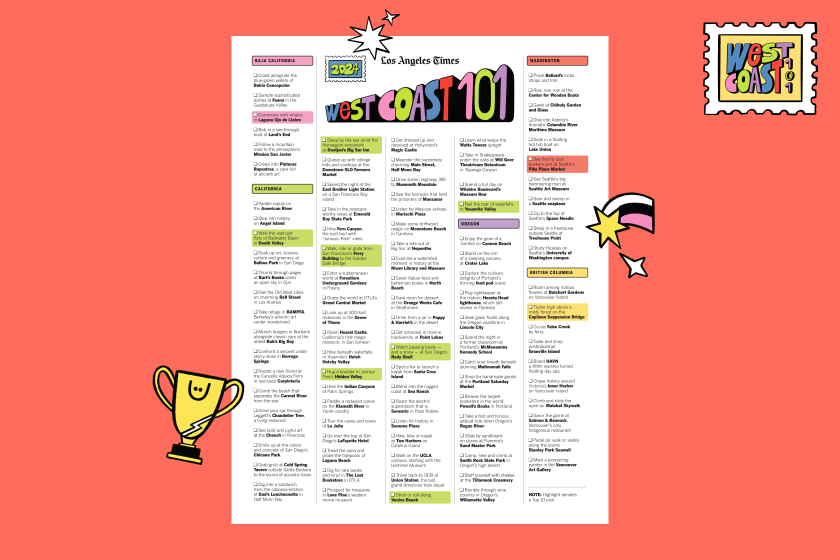The Color of Spring
With a deft, strong flip of her wrist, Elizabeth Billet wrenches a branch from a 7-foot-tall lilac bush, then instinctively sniffs the aroma of the heavy red-purple buds just barely hinting to unfold.
Dwarfed in the hedgerow acres of lilacs planted by her father and grandfather more than half a century ago, Billet surveys the cloud cover and predicts these will be ready in a few days, popping out with the warming rays of the sun.
And so the spring ritual begins again for Billet, 64, and her husband, Ray Billet, 65, third-generation owner-operators of the 110-year-old Blum Ranch in this High Desert hamlet on the chilly north slopes of Angeles National Forest.
This is lilac country, where the seasonal blooms rival the more traditional scenes of New Hampshire and other East Coast locales. The freezing nights here coax buds to form on plants thought to have originated in the 13th century in western China.
“We just grow them and sell them. We don’t know the names of the varieties,” said Billet, snapping off unsightly branches by rote from fistfuls of 36-inch-long stems as she spoke. “We are totally dependent on the weather. This is part of our livelihood.”
The heavy branches of white, muted lavender or deep purple flowerets droop from bushes all over the countryside, in private yards as well as on a few ranches where they are commercially grown or cultivated in preserves.
But the Blum Ranch--which has four acres of lilacs among 65 acres of peach, pear and almond orchards--is the last commercial grower of lilacs in Los Angeles County to still sell flowers to the public, agricultural and lilac specialists said. Armful-size bunches of the aromatic flowers are available to visitors this year for $12 each.
The Billets harvested a record crop of lilacs last year, selling about 5,000 bunches, mostly to wholesalers who ship them all over the West. Last year’s crop, which continued to produce until Mother’s Day in mid-May, drew hundreds of visitors eager to buy direct from the grower. Postcards have been sent to about 2,300 people on a mailing list.
Although visitors are prohibited from cutting their own stems, they are allowed to walk through the fields of towering plants. The store operates daily from 8 a.m. to 6 p.m. for as long as the blooms last, expected to be through the end of the month. Updates on the availability of flowers are available by calling (661) 947-2796. The ranch, at 31880 Aliso Canyon Road, is south of the Antelope Valley Freeway (14) off the Santiago Road exit.
The Blum Ranch crop is small compared with that of the 60-acre Columbo Ranch in Acton, where vast fields of the flowers are harvested for wholesalers. But Columbo stopped selling to the public in 1994.
The only other commercial grower that still sells retail in Southern California is the Manzanita Ranch, just outside historic Julian and Cleveland National Forest in San Diego County. It is also a third-generation operation; co-owner Woody Barnes said he expects to harvest the first blooms sometime next week.
“This weather is just like a big refrigerator,” said Barnes, 66. “We won’t get any blooms until the sun comes out.” What he fears most is an overnight temperature drop to below 20 degrees, a freeze that could kill the delicate buds before they open.
This is the last year that Manzanita Ranch owners will operate their own retail sales, Barnes said. A new owner in May will take over operation of the ranch store, at 4470 Highway 78. Manzanita, which also has been selling lilacs since the 1940s, charges $10 a bunch for the blooms, including tax. Retail sales are daily from 10 a.m. to 5 p.m. Visitors are advised to call the ranch at (760) 765-0102 to determine availability.
The Billets expect to reap 3,000 to 4,000 bunches this year from plants that typically produce fewer stems after a bumper crop. With the help of more than a dozen pickers and packers, the couple and their crew work from dawn to dusk during the four to six weeks of harvest.
The fresh-picked stems are bundled and plunged into buckets of water, then kept in cold storage until sold in a warehouse chilled to 35 degrees by a bank of refrigerator compressors.
The Billets say the flowers can last up to two weeks if the woody bottoms of the stems are crushed to better absorb water, which should be changed daily.
Perhaps the most famous location for viewing lilacs in Southern California is Descanso Gardens in La Canada Flintridge. The 160-acre public garden offers tours of its “Lilac Grove,” where 50 varieties are grown, on Saturdays from 9 to 11 a.m. throughout April.
Cut flowers are not available, but hybridized plants can be purchased, said Rudy Schaffer, volunteer lilac curator at the gardens, located at 1418 Descanso Drive. Admission is $5 general, $3 students and seniors and $1 for children. Information is available by calling (818) 952-4400.
Sign up for The Wild
We’ll help you find the best places to hike, bike and run, as well as the perfect silent spots for meditation and yoga.
You may occasionally receive promotional content from the Los Angeles Times.



